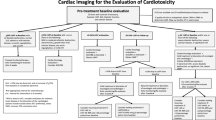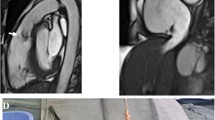Abstract
Purpose of Review
Cardiac magnetic resonance imaging has a significant and expanding role to play in contemporary cardio-oncology. This review seeks to explore the current and future roles of this imaging modality in the cardio-oncology setting.
Recent Findings
Cardiac magnetic resonance imaging is required in diagnosing, monitoring and treating all types of cardiotoxicities (acute coronary syndromes, arrhythmias, myocarditis, pericardial disease, heart failure) and in all types of cancers (breast, gastrointestinal, renal, prostate, haematological etc.). Newer imaging sequences and techniques can help provide additional information and shorten imaging times.
Summary
Cardiac magnetic resonance imaging is an integral part of the holistic management of cardio-oncology patients, with increasingly expanding applications in the area.





Similar content being viewed by others
References
Papers of particular interest, published recently, have been highlighted as: • Of importance
Ammon M, Arenja N, Leibundgut G, et al. Cardiovascular management of cancer patients with chemotherapy-associated left ventricular systolic dysfunction in real-world clinical practice. J Card Fail. 2013;19:629–34.
Parent S, Pituskin E, Paterson DI. The cardio-oncology program: a multidisciplinary approach to the care of cancer patients with cardiovascular disease.Can J Cardiol 2016;32:847–51
Koene RJ, et al. Shared risk factors in cardiovascular disease and cancer. Circulation. 2016;133:1104–14.
Lara F. Nhola, Hector R. Villarraga. Fundamentos de las unidades de cardio-oncología. Rev Esp Cardiol. 2017.
Esmée C de Baat, Willeke R Naaktgeboren, Tim Leiner, Arco J Teske, Jesse Habets, Heynric B Grotenhuis. Update in imaging of cancer therapy-related cardiac toxicity in adults. Open Heart. 2021;8.
Juan Carlos Plana, Paaladinesh Thavendiranathan, Chiara Bucciarelli-Ducci, Patrizio Lancellotti. Multi-modality imaging in the assessment of cardiovascular toxicity in the cancer patient. JACC: Cardiovascular Imaging. 2018;11.
Zamorano JL, Lancellotti P, Rodriguez Muñoz D, Abóyanos V, Asteggiano R, Galderisi M, et al. 2016 ESC Position Paper on cancer treatments and cardiovascular toxicity developed under the auspices of the ESC Committee for Practice Guidelines: the Task Force for cancer treatments and cardiovascular toxicity of the ESC. Eur Heart J. 2016;37:2768–801.
Iwan Harries, Kate Liang, Matthew Williams, Bostjan Berlot, Giovanni Biglino, Patrizio Lancellotti, Juan Carlos Plana, Chiara Bucciarelli-Ducci. Magnetic resonance imaging to detect cardiovascular effects of cancer therapy. JACC: Cardiooncology. 2020;2.
Christopher E.D. Saunderson, Sven Plein and Charlotte H. Manisty. Role of cardiovascular magnetic resonance imaging in cardio-oncology. Europ Heart J - Cardiovas Imag. 2021;22:383–96.
Pons-Lladó G. Protocols for cardiac MR and CT. Springer. 2016:978–3–319–30830–2.
Weinsaft JW, Kim J, Chaitanya B, et al. Echocardiographic algorithm for post-myocardial infarction LV thrombus: a gatekeeper for thrombus evaluation by delayed enhancement CMR. JACC: Cardiovasc Imag. 2016;9:505–15
Armstrong GT, Plana JC, Zhang N, et al. Screening adult survivors of childhood cancer for cardiomyopathy: comparison of echocardiography and cardiac magnetic resonance. J Clin Oncol. 2012;30:2876–84.
Pennell DJ, Sechtem UP, Higgins CB, et al. Clinical indications for cardiovascular magnetic resonance (CMR): consensus panel report. Eur Heart J. 2004;25:1940–65.
Jordan JH, Todd RM, Vasu S, Hundley WG. Cardiovascular magnetic resonance in the oncology patient. J Am Coll Cardiol Img. 2018;1:1150–72.
Meléndez GC, Sukpraphrute B, D’Agostino RB, et al. Frequency of left ventricular end-diastolic volume–mediated declines in ejection fraction in patients receiving potentially cardiotoxic cancer treatment. J Am Coll Cardiol. 2017;119:1637–42.
Scholtz L, Sarkin A, Lockhat Z. Current clinical applications of cardiovascular magnetic resonance imaging. Cardiovasc J Africa. 2014;25.
Galán-Arriola C, Lobo M, Vílchez-Tschischke JP, et al. Serial cardiac magnetic resonance to identify early stages of anthracycline-induced cardiotoxicity. J Am Coll Cardiol. 2019;73:779–91.
Ferreira de Souza T, Quinaglia AC Silva T, Osorio Costa F, et al. Anthracycline therapy is associated with cardiomyocyte atrophy and pre-clinical manifestations of heart disease. J Am Coll Cardiol Img. 2018;11:1045–55.
Ammirati E, Frigerio M, Adler ED, Basso C, Birnie DH, Brambatti M, et al. Management of acute myocarditis and chronic inflammatory cardiomyopathy. Circulation: Heart Failure 2020;13.
Kremastinos DT, Farmakis D. Iron overload cardiomyopathy in clinical practice. Circulation. 2011;124:2253–63.
Aronow WS. Management of cardiac hemochromatosis. Arch Med Sci. 2018;14:560–8.
Anderson LJ, Holden S, Davis B, Prescott E, Charrier CC, Bunce NH, et al. Cardiovascular T2-star (T2*) magnetic resonance for the early diagnosis of myocardial iron overload. Eur Heart J. 2001;22:2171–9.
Mitchell JD, Cehic DA, Morgia M, Bergom C, Toohey J, Guerrero PA, et al. Cardiovascular manifestations from therapeutic radiation. JACC: Cardiooncol. 2021;3.
Geske JB, Reddy YNV. Pathophysiology and diagnosis of constrictive pericarditis. American College of Cardiology. [On line] 13 de March de 2017. [Cited: 16 de May de 2022.] https://www.acc.org/latest-in-cardiology/articles/2017/03/13/15/10/pathophysiology-and-diagnosis-of-constrictive-pericarditis.
Lancellotti P, Nkomo VT, Badano LP, Bergler-Klein J, Bogaert J, Davin L, et al. Expert consensus for multi-modality imaging evaluation of cardiovascular complications of radiotherapy in adults: a report from the European Association of Cardiovascular Imaging and the American Society of Echocardiography. Eur Heart J Cardiovasc Imaging. 2013;14:721–40.
Mitchell JD, Cehic DA, Morgia M, Bergom C, Toohey J, Guerrero PA, et al. Cardiovascular manifestations from therapeutic radiation: a multidisciplinary expert consensus statement from the International Cardio-Oncology Society. JACC: Cardiooncol. 2021;3:360–80.
Zamorano JL, Lancellotti P, Muñoz DR, Aboyans V, Asteggiano R, Galderisi M, et al. ESC Position Paper on cancer treatments and cardiovascular toxicity developed under the auspices of the ESC Committee for Practice Guidelines. Eur Heart J. 2016;2016(37):2768–801.
Gatti M, Carisio A, D’Angelo T, Darvizeh F, Dell’Aversana S, Tore D, et al. Cardiovascular magnetic resonance in myocardial infarction with non-obstructive coronary arteries patients: a review. World J Cardiol. 2020;12:248–61.
Tilman Emrich, Moritz Halfmann U. Joseph Schoepf and Karl-Friedrich Kreitner. CMR for myocardial characterization in ischemic heart disease: state-of-the-art and future developments. Europ Radiol Exp. 2021;5.
Keramida K, Farmakis D, Filippatos G. Cancer and Takotsubo syndrome: from rarity to clinical practice. ESC Heart Failure. 2021;8:4365–9.
Ederhy S, Cautela J, Ancedy Y, Escudier M, Thuny F, Cohen A. Takotsubo-like syndrome in cancer patients treated with immune checkpoint inhibitors. J Am Coll Cardiol Img. 2018;11:1187–90.
Placido R, Cunha Lopes B, Almeida AG, Rochitte CE. The role of cardiovascular magnetic resonance in takotsubo syndrome. J Cardiovasc Magn Reson 2017;18.
Salem JE, Manouchehri A, Moey M, Lebrun-Vignes B, Bastarache L, Pariente A, et al. Cardiovascular toxicities associated with immune checkpoint inhibitors: an observational, retrospective, pharmacovigilance study. Lancet Oncol. 2018;19:1579–89.
Spallarossa P, Sarocchi M, Tini G, Arboscello E, Toma M, Ameri P, et al. How to monitor cardiac complications of immune checkpoint inhibitor therapy. Front Pharmacol 2020;11.
Bonaca MP, Olenchock BA, Salem J-E, Wiviott SD, Ederhy S, Cohen A, et al. Myocarditis in the setting of cancer therapeutics proposed case definitions for emerging clinical syndromes in cardio-oncology. Circulation. 2019;140:80–91.
Caforio AL, Pankuweit S, Arbustini E, Basso C, Gimeno-Blanes J, Felix SB, et al. Current state of knowledge on aetiology, diagnosis, management, and therapy of myocarditis: a position statement of the European Society of Cardiology Working Group on Myocardial and Pericardial Diseases. Eur Heart J. 2013;34:2636–48.
Thavendiranathan P, Zhang L, Zafar A, Drobni ZD, Mahmood SS, Cabral M, Awadalla M. Myocardial T1 and T2 mapping by magnetic resonance in patients with immune checkpoint inhibitor–associated myocarditis. J Am Coll Cardiol. 2021;12:1503–16.
• Zhang L, Awadalla M, Mahmood SS, Nohria A, Hassan MZO, Thuny F, et al. Cardiovascular magnetic resonance in immune checkpoint inhibitor-associated myocarditis. Eur Heart J. 2020;41:1733–43. Important review on the role of cardiac magnetic resonance imaging in this newer cardiotoxicity.
Aldweib N, Farah V, Biederman RW. Clinical utility of cardiac magnetic resonance imaging in pericardial diseases. Current Cardiology Reviews 2018;14:200–212.
Bogaert J, Francone M. Cardiovascular magnetic resonance in pericardial diseases. J Cardiovasc Magn Resonance. 2009;11.
Drazner MH. The progression of hypertensive heart disease. Circulation. 2011;123:327–34.
Mavrogeni S, Katsi V, Vartela V, et al. The emerging role of cardiovascular magnetic resonance in the evaluation of hypertensive heart disease. BMC Cardiovasc Disord. 2017;17:132.
Maceira AM, Mohiaddin RH. Cardiovascular magnetic resonance in systemic hypertension. J Cardiovasc Magn Resonance. 2012;14:28.
Fussen S, De Boeck BW, Zellweger MJ, Bremerich J, Goetschalckx K, Zuber M, et al. Cardiovascular magnetic resonance imaging for diagnosis and clinical management of suspected cardiac masses and tumours. Eur Heart J. 2011;32:1551–60.
Motwani M, Kidambi A, Herzog BA, Uddin A, Greenwood JP, Plein S. MR imaging of cardiac tumors and masses: a review of methods and clinical applications. Radiology. 2013;268:26–43.
Li X, Chen Y, Liu J, Lei Xu, Li Yu, Liu D, Sun Z, Wen Z. Cardiac magnetic resonance imaging of primary cardiac tumors. Quant Imaging Med Surg. 2020;10:294–313.
• Sultan FA, Ahmed SW. Cardiac magnetic resonance evaluation of cardiac masses in patients with suspicion of cardiac masses on echo or computed tomography. J Clin Imag Sci. 2020;10. Good primer on how to evaluate cardiac masses from an imaging perspective.
Grogan M, Dispenzieri A, Gertz MA. Light-chain cardiac amyloidosis: strategies to promote early diagnosis and cardiac response. Heart. 2017.
Bhatti S, Watts E, Syed F, Vallurupalli S, Pandey T, Jambekar K, et al. CMR in patients with myeloma with suspected cardiac amyloidosis. Euro Heart J Cardiovasc Imaging. 2016.
Maceira AM, Joshi J, Prasad SK, Moon JC, Perugini E, Harding I, et al. Cardiovascular magnetic resonance in cardiac amyloidosis. Circulation. 2005;111:186–93.
Haaf P, Garg P, Messroghli DR, Broadbent DA, Greenwood JP, Plein S. Cardiac T1 mapping and extracellular volume (ECV) in clinical practice: a comprehensive review. J Cardiovasc Magn Reson. 2016;18:89.
Author information
Authors and Affiliations
Corresponding author
Ethics declarations
Conflict of Interest
The authors declare no conflict of interest.
Human and Animal Rights and Informed Consent
This article does not contain any studies with human or animal subjects performed by any of the authors.
Additional information
Publisher's Note
Springer Nature remains neutral with regard to jurisdictional claims in published maps and institutional affiliations.
This article is part of the Topical Collection on Cardio-Oncology
Rights and permissions
Springer Nature or its licensor (e.g. a society or other partner) holds exclusive rights to this article under a publishing agreement with the author(s) or other rightsholder(s); author self-archiving of the accepted manuscript version of this article is solely governed by the terms of such publishing agreement and applicable law.
About this article
Cite this article
Pons-Riverola, A., Ghosh, A.K. An Update on the Role of Cardiac Magnetic Resonance Imaging in Cancer Patients. Curr Cardiol Rep 24, 2139–2147 (2022). https://doi.org/10.1007/s11886-022-01818-x
Accepted:
Published:
Issue Date:
DOI: https://doi.org/10.1007/s11886-022-01818-x




